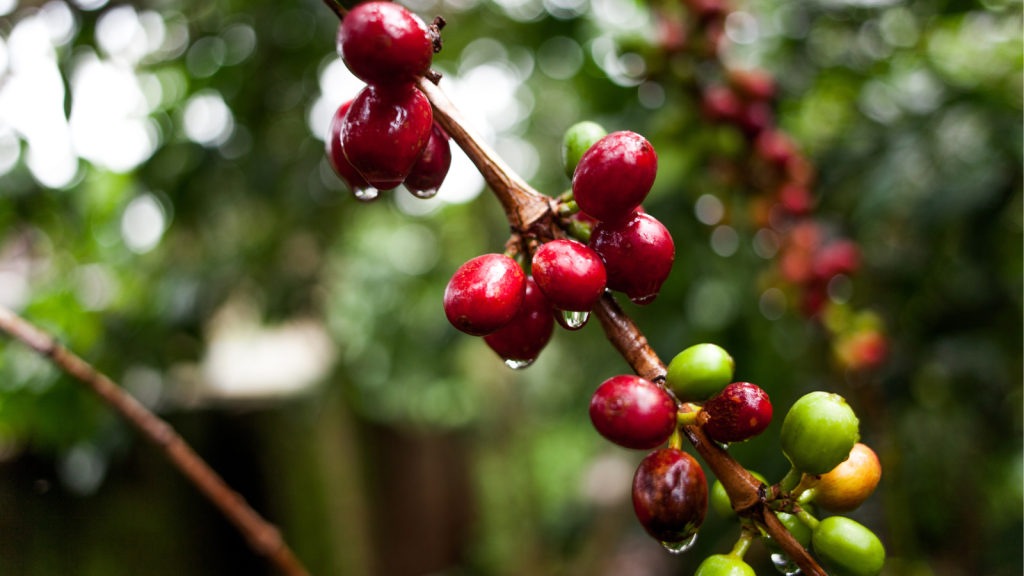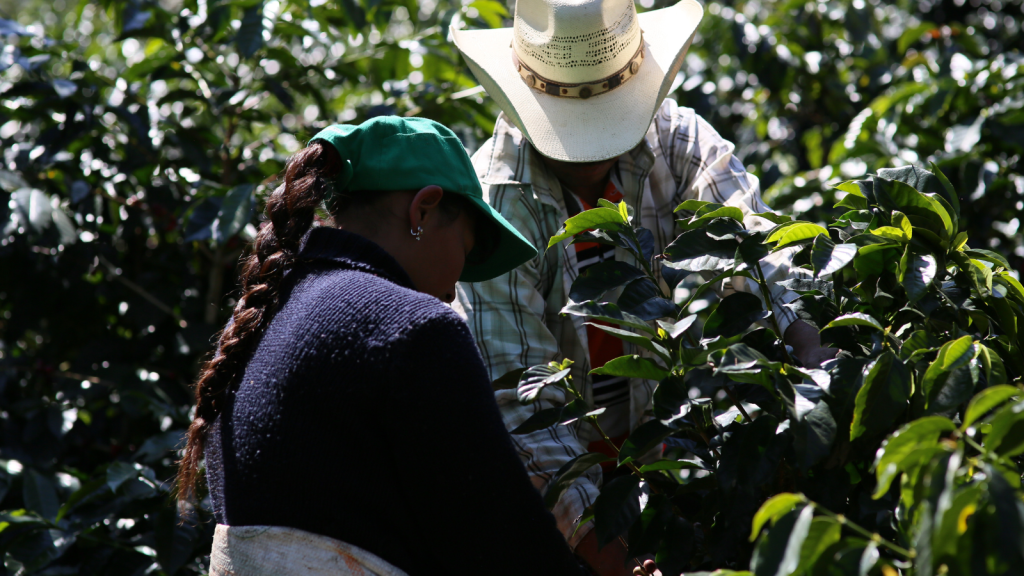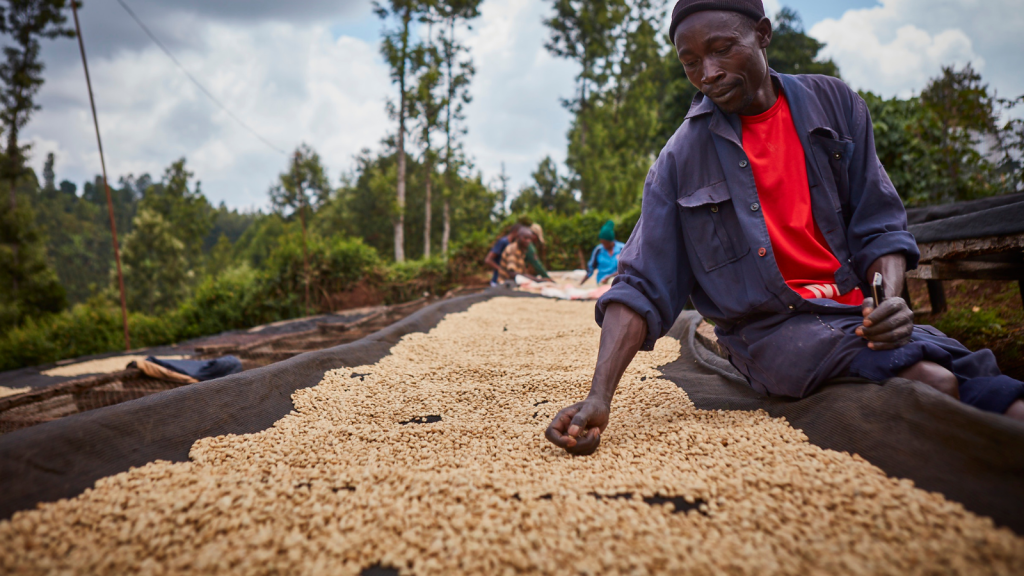How much are you willing to pay for a cup of coffee? Depending on your daily habits, coffee can either be a morning necessity or a luxury lifestyle. While some may already grumble at the thought of a $5 latte, more and more specialty coffee shops are offering truly exclusive coffees that cost $20-$30 for a single cup. Let’s take a look at some of the world’s most expensive coffees and why people are willing to pay the price to roast and enjoy them.

Ripe red coffee cherries in Uganda dripping with dew
What Makes Coffee Expensive?
Before we get into the most expensive cups, let’s first cover what goes into the price of coffee. The price of any coffee (green coffee beans and, thus, roasted coffee) is determined by several factors, including the C-market, green coffee differentials, and macroeconomic factors, like the current state of the supply chain. Let’s break down those terms a bit first.
The C-market is the primary source for pricing green coffee beans, and this regulated futures exchange sets the benchmark. There are two exchanges, one for arabica and one for robusta. They are traded as commodities by market participants who may or may not be directly involved in the coffee consumption industry. The value of Arabica green coffee is expressed in US cents per pound, while the value of Robusta green coffee is expressed in US dollars per ton (1,000kg).
The C-market price of green coffee is often used as a reference point when negotiating the purchase price of physical green coffee with producers. When quality, origin, processing method, and other characteristics of the green coffee beans are taken into account, a differential premium is applied to the C-market price, thus determining the final purchase price of the coffee.
Understanding green coffee price differentials is important for anyone involved in trading or investing in green coffee beans, including coffee roasters. Differentials indicate the quality of the green coffee beans they buy compared to the C-market price.
The overall price of green coffee rises and falls with supply and demand. That’s why macroeconomic factors like unseasonal frost in Brazil, the world’s largest coffee producer, shipping delays brought on by COVID-19, and raw material shortages due to the war in Ukraine can cause a price surge in how much green coffee costs.
Why Are Some Coffees More Expensive Than Others?
While macroeconomic environments affect the general base price of green coffee, the prices of the most expensive coffee beans in the world are less sensitive to C-market fluctuations. One key contributing factor to why some coffee beans are so expensive is how it’s produced.
Instead, characteristics like producer reputation, country of origin, coffee varietal, and processing method are factored into green coffee prices. For example, Costa Rica is known for pricing its coffee at a premium because the country has a higher standard for socio-economic infrastructure that protects workers and encourages education. Similarly, rare coffee species like Coffea eugenioides or fragile arabica varietals like gesha are expensive because they’re scarce and are grown at low volumes.
Before bags of coffee are traded, they must first be evaluated on the cupping table by quality control experts on both sides of the import/export exchange. Coffee is graded according to the presence of defects in the beans, as well as the aroma and flavor of the brewed coffee.
For a batch of coffee beans to be considered specialty grade, they must receive a cup score of 80 points or higher. But, of course, some coffees go above and beyond. Truly exceptional coffees can score over 90 points and are thus priced accordingly.
Some coffee producers aim for exceptional coffees through innovation in their processing methods. While most producers still use natural or washed processing for their coffee cherries, new techniques like carbonic maceration, thermic experiments, or exotic fermentation practices can add both flavor and value to a batch of coffee cherries.
For some of the most expensive coffees in the world, processing makes all the difference. That’s why the first coffee on this list, and maybe the most (in)famous of them all, is Kopi Luwak, commonly referred to as cat poop coffee.

Picking coffee in Guatemala
What Are the Most Expensive Coffees in the World?
These green coffee beans are typically priced so high because they are rare, difficult to cultivate or have a unique flavor profile. While the prices are estimates and can vary depending on the producer or region, these coffees have established a reputation for themselves as premium luxuries, highly exclusive, or both, and not for your average coffee consumer. The average prices listed are for unroasted green coffee beans and, of course, sell for much higher retail prices when roasted.
Indonesia Kopi Luwak ($160/lb)
Kopi Luwak coffee beans are produced in Indonesia by feeding coffee cherries to civet cats, who are naturally inclined to eat the ripest, sweetest cherries. Their digestive systems break down the cherries and ferment the beans, which are then harvested from the cat’s poop. Due to the popularity of Kopi Luwak coffee beans, the industry surrounding it is prone to fraud and animal abuse in order to cash in on the premium prices. However, ethically-certified, wild-sourced Kopi Luwak exists and can cost up to $600 per pound of coffee beans. That’s definitely expensive, but the world’s most expensive coffees are yet to come.
Hawaii Kona ($49/lb)
In the frenzy over exotic coffees from around the world, we sometimes forget that US-grown coffee can be just as delicious and exciting. Kona coffee grows on a small stretch of volcanic slopes on Hawaii. Limited production and a distinct flavor profile of chocolate, nuts, and fruit make Kona coffee highly prized and can reach up to $75 per pound, particularly when it comes from a highly reputable estate. Kona is certainly expensive, but this is just the tip of the iceberg.
Jamaica Blue Mountain ($45/lb)
In a similar fashion, Jamaica Blue Mountain coffee beans are exclusively grown in the Blue Mountains of, you guessed it, Jamaica. The unique micro-climate and strict quality control regulations add to the high price point of Blue Mountain coffee beans. Still, fans of this premium coffee are willing to pay for its distinct chocolate flavor profile with low acidity. Bags of 100% certified Jamaica Blue Mountain coffee beans can cost up to $140 per pound. Keep reading, coffee can get a lot more expensive.

Sorting and drying coffee in Kenya
Yemen ($246.5/lb)
Coffee from Yemen is experiencing a surge in popularity, particularly from a genetic research perspective. After its discovery in Ethiopia, arabica coffee traveled to Yemen, where it was first cultivated and transformed into a beverage before disseminating worldwide. That’s why over 98% of the cultivated varietals around the world can be traced back to Yemeni coffee. If you think about modern coffee varietals as genetic photocopies of a mother coffee population, Yemenia coffee would be the original copy and thus holds high potential for new varietals.
While coffee beans from Yemen generally start at $25 to $60 per pound, the top-scoring coffee at the Best of Yemen auction in 2022 was sold for $246.5 per pound for a 105.2-pound lot produced by Hifthallah Alhaymi.
Cup of Excellence (various origins, up to $400.5/lb)
It’s no surprise that auction lot coffee beans are expensive. The Cup of Excellence (COE) is a competition and education program that operates in 15 countries. Thousands of coffees are submitted for COE evaluation every year, and winning coffees are sold via an auction platform managed by The Alliance for Coffee Excellence. These coffees have all been cupped a minimum of five times and received a cup score of over 87 points.
To give you an idea of how much COE auction coffee costs, here are the prices that top-ranking lots in 2022 were sold for:
-Brazil (Fazenda Tijuco): $43/lb
-Colombia (La Bohemia): $92.2/lb
-Costa Rica (Don Cayito): $140.1/lb
-Ecuador (Hacienda Lugmapata): $105.1/lb
-El Salvador (El Conacaste): $72.2/lb
-Ethiopia (Legese): $400.5/lb
-Guatemala (El Morito): $138.2/lb
-Honduras (La Salsa): $134/lb
-Mexico (Finca Santa Cruz): $92/lb
-Nicaragua (El Avión): $25.2/lb
-Peru (La Bola): $78.5/lb
Best of Panama ($2,568/lb) | Almost the Most Expensive Coffee
If you thought COE sounded expensive, the Best of Panama (BoP) auction is definitely not for the faint of heart. BoP is a platform for Panamanian producers, and where the potential of geisha coffee was first discovered in an explosive auction lot submitted by Hacienda La Esmeralda in 2004. Finca Nuguo holds the BoP record for the most expensive coffee with their 2021 natural fermented geisha auction lot that sold for $2,568 per pound. With a lot size of 100 lbs, the total value of this coffee was $256,800.
Geisha/Gesha ($6,034/lb) | The Most Expensive Coffee
As you can see, geisha or gesha green coffee beans, depending on where they’re produced, are one of the world’s most expensive coffee beans. Why is geisha coffee so expensive? Because it’s a low-yielding, delicate varietal that happens to taste unlike any other coffee out there.
It’s a world apart from the deep, chocolatey flavor profile of earlier favorites like Kona or Blue Mountain coffee, and its floral, tea-like character is highly coveted among specialty coffee drinkers. That’s why it consistently scores highly on cupping tables, auction rankings, or competition stages. Sipping a cup of geisha filter coffee at a café can set you back anywhere between $10-$30, depending on where the coffee comes from.
The current record for the most expensive coffee in the world (as of February 2023) is a Panamanian geisha from the Elida Estate, run by the Lamastus family. In a private auction in September 2022, 24 lots of coffee produced on the Lamastus estates, totaling 1,762 pounds of coffee, were sold at an average price of $341.21 per pound.
The record-breaking coffee, however, was a 7-pound lot of geisha coffee grown at an ultra-high elevation above 2,000masl and honey processed. So how much does the most expensive coffee in the world cost?
A jaw-dropping $6,034 per pound for this unroasted geisha green coffee.
Coffea eugenioides ($400/lb, roasted)
Although $400 per pound of eugenioides coffee beans might not seem exorbitant compared to some of the prices mentioned above, Coffea eugenioides is an example of exclusivity that money can’t buy. This ultra-rare coffee species is still being researched, and primary production is limited to Finca Inmaculada in Colombia, where it’s grown in very, very small quantities.
Like geisha coffee, the cup profile of eugenioides is unlike any other, with unusual notes of toasted marshmallow, confectioner’s sugar, lemon drop, and grilled pineapple. Unless you have a direct relationship with Finca Inmaculada or a green coffee trader with access to the estate, you’d be hard-pressed to get your hands on unroasted eugenioides green coffee.
At the time of writing on 23 February 2023, the C-market price of arabica coffee was $1.9126 per pound. Clearly, the long arm of the C-market only stretches so far.






